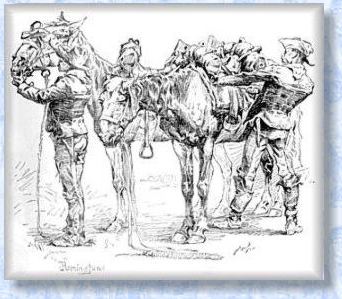|
|
Buffalo Soldiers at Fort Larned

"SADDLE UP" - Drawn by Frederic Remington
Harper's Weekly, Sep. 4, 1886
The Buffalo Soldiers Nicknamed Buffalo Soldiers supposedly by the Indians because of the similarity between their hair and the coat of the buffalo, many soldiers of the black regiments were recruited from the United States Colored Troops which served in the Civil War. Other enlistees came from the New Orleans area, the fringes of the southern states and from large northern cities. They were former slaves as well as freedmen.
On July 28, 1866, Congress established a peacetime army, drastically reducing the size of the force, and abolishing all the African American units created during the Civil War. Four new cavalry regiments were created, however, including two "composed of colored men, having the same organization as is now provided by law for cavalry regiments." Four new "colored" infantry units were also created. The six new black units were the 9th and 10th Cavalry and the 38th, 39th, 40th and 41st Infantry. (The infantry units were later consolidated into the 24th and 25th Infantry Regiments). The four black regiments, two infantry and two cavalry, remained in the West until the Spanish American War . During this period, the U.S. Army consisted of just 10 cavalry and 25 infantry regiments, meaning that one in five cavalry soldiers and one in eight infantry soldiers were black.
The first black cavalry unit assigned to duty in the US Army after the Civil War arrived in April, 1867 to Fort Larned. Company A of the 10th garrisoned at Fort Larned until 1869. They were commanded by a white officer, Captain Nicholas Nolan. Nolan was an Irish man who arrived in the US before the Civil War. He became a career soldier who would serve in the Dragoons, Artillery and Cavalry. During and after the Civil war, African American regiments were composed entirely of black troop, commanded exclusively by white officers. There were three exceptions, however. Although there were several appointments of African Americans to West Point during the 19th century, just three black cadets (Henry O. Flipper , John H. Alexander and Charles Young ) graduated, and all were assigned to African units.
Conditions at Fort Larned were not as bad as those found at other army posts. Although the barracks had no ceiling and plaster still needed to be placed on some of the walls there was, at the least, a commander in charge of the post from their own regiment, Major Meridith Kidd. Treatment would be much better from this commander. When Major Kidd left the post in 1868 and the new commander arrived, Major John Yard (also of the Tenth US Cavalry), things began to change. On the morning of the 2nd of January 1869 about half past six or seven O'clock the stables of "A" Co. 10th Cavalry burned down--probably arson. The previous evening at the Saloon run by the Sutler, there was a soldier fight between a couple members of Company C, 3rd Infantry and two soldiers from the 10th Cavalry over a billiards table. Major Yard, Commanding Officer at Fort Larned, sent the Buffalo Soldiers of Company A about one half mile from the fort to guard a wood pile, although a severe snow-storm was raging at the time. It was said that the stables had two members of the 10th Cavalry inside and a guard from the 3rd Infantry regiment patrolled outside. Neither discovered the fire, it was reported by the 19th Kansas Vol. Cavalry who was camped about four hundred yards away. Thirty-nine horses, 30 tons of hay, 500 bushels of grain, 40 saddles, 45 Spencer carbines, 47 light sabers and 6000 rounds of ammunition were destroyed. Captain Nolan protested the treatment of his company in a letter to Colonel Grierson to no avail.
The truth of what really happened that January night the stables burned down is lost in history but what we do know to be true is that the stables were gone. Friction between the black and white troops had reached a near riot level. Major Yard decided to transfer his own men (Company A) to Fort Zarah where they did detachments to Fort Harker and Fort Hays. Nolan and his men would later leave Kansas and go to Fort Sill in Indian Territory where the rest of the regiment had found itself after leaving Fort Riley.
|
|
|
|
|
 Military Chronology
Military Chronology
